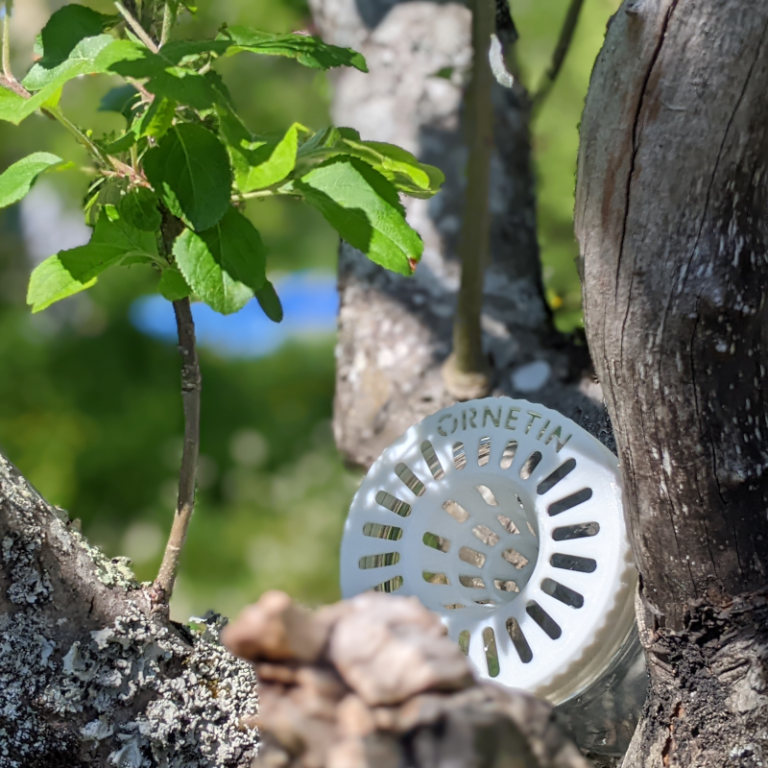
Trapping the Asian Hornet: Different Approach Outside Beekeeping Areas
Trapping the Asian hornet away from beekeeping areas requires a different approach. The reason is simple: the hornets do not come with the same intention. In a vegetable garden, they are mostly looking for carbohydrates, whereas in a beekeeping area, they are searching for proteins. Thus, to trap hornets in a garden, a different strategy is needed.
Attractive Plants for Asian Hornets
For individuals who do not have beehives but maintain a garden, a park, terrace planters, or flowered balconies, here are the various plants, fruit trees, and scents that attract Asian hornets:
- Fragrant Plants: Asian hornets are attracted to plants that emit strong, sweet odors. For example, the Buddleia, commonly known as the “butterfly bush,” can attract them due to its sweet scent.
- Nectar-Rich Flowers: Flowers that produce a lot of nectar can also attract hornets. These include certain varieties such as geraniums, hollyhocks, and ivy flowers.
- Fruit Trees: Asian hornets are particularly attracted to fruit trees, especially when they produce ripe, sweet fruits. This includes fig trees, cherry trees, apple trees, and pear trees.
- Nectar from Certain Flowers: Asian hornets can also be drawn to the nectar of specific flowers, notably rhododendrons and azaleas.
Baiting Without Competing with Surrounding Resources
In a garden, where attractive plants like vines or fig trees may abound in carbohydrate sources, the use of bait must be strategic. The effectiveness of a trap will depend on its ability to stand out in such an environment. Unlike beekeeping areas, trapping in a garden presents varying challenges that require careful observation and adaptive strategies.
We encourage sharing experiences to better understand approaches that work in contexts similar to yours. Consult contributions from other users for practical advice and suitable solutions. If you have experiences to share or questions to ask, feel free to contact us via our contact form.
Garden Trapping: Sharing Experiences
Vines and Waxes
- Lorenzo: At my place, a trap set on the vine is ineffective, even though hornets are swarming and feasting on the grapes. However, another trap located 5 meters away, next to a storage area with hives and waxes, is very successful!
Apple Trees and Camellias
- Patrick: Initially, under an apple tree, I was disappointed by the low number of hornets trapped. However, this fall, I was pleasantly surprised by a capture with three traps under a camellia. One of the traps captured 123 hornets in 48 hours! I didn’t count the captures in the other traps, but this experience corroborates your advice: multiplying traps even in a small area is beneficial (my camellia is much smaller compared to my apple tree, which may explain the difference in results, along with the current scarcity of food).
Another interesting point: I captured three non-Asian hornets under my apple tree (easily identifiable by the size and color differences in the abdomen).
My latest traps are exclusively made with paper towels soaked in grenadine, and this combination gives me the best results (better than using cotton or dry herbs as you mentioned). I observed that hornets come to the trap entrance and seem to exchange soaked paper crumbs with their counterparts inside.
Figs
- Petrena and Jonathan: We can tell you that now your trap works! For the past week, under the fig tree where there are many Asian hornets, we catch between 10 and 15 per day. Not more, but it works. We use straw, two small pieces of ripe fig, a small spoonful of honey, and a bit of lime syrup. European hornets also enter, but that’s okay.
In the last two weeks, with the sun and heat, there were many hornets in our fig tree. Why the trap works now, I don’t know! But the success absolutely encourages us to try next year with different contents if necessary.
If you want to learn more about why Ornetin is superior for trapping hornets and how it differs from other trapping systems, you can read an article Why Ornetin is different?
If you have feedback to share, write to us via the contact form.
